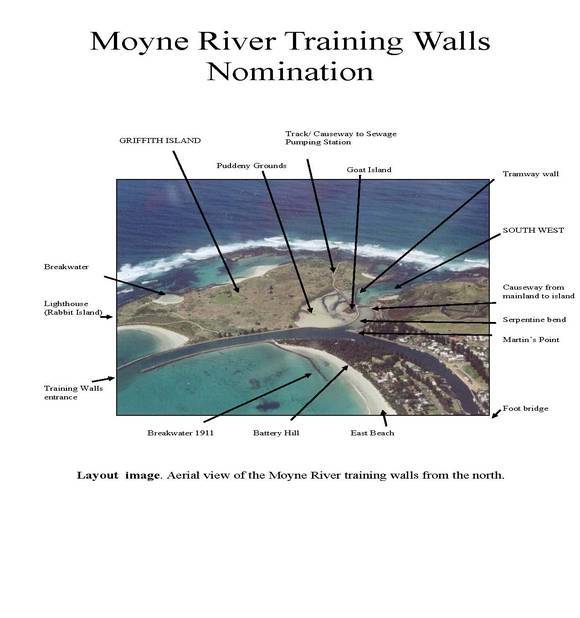| Back to search results » | Back to search page » |
|
Moyne River Training Walls
LocationEither side fo Moyne River and SW Passage,, PORT FAIRY VIC 3284 - Property No B7366
File NumberB7366LevelState |
|
Statement of Significance
'The Port Fairy training walls are one of Victoria's significant nineteenth century port infrastructure investments. The works were undertaken to allow seaborne trade to develop at Belfast/Port Fairy, after the pier into the bay proved a failure. River access for coastal vessels was achieved in 1873, and the works were essential for the town's development, as a railway link was not achieved until 1890. The project was sustained over sixty years by budget allocations and irregular capital tranches, using successive contractors between 1869 and 1874 by when the basic plan was achieved. The battered basalt walls contain and project the river flow into the bay, making use of coastal wave force to project the suspended river silt through the mouth, although the envisaged 'self-flushing' action was never fulfilled. 2010 Note: Walls under conservation and repair.
Why is it significant? The Moyne River training walls are significant for scientific (technical) reasons at a State level. The walls are significant for aesthetic and historic reasons at a local level.
How is it significant? Scientific/Technical assessment: The Moyne River training walls are a significant nineteenth civil engineering project which sought to use the particular design and geography to use the power of the sea to provide impetus to the river to carry suspended sediment into the bay, beyond the mouth of the river. The concept was developed by E O Moriarty using his experience of N.S.W. river ports in 1864, with alterations by W H Steel (Inspector-General, Public Works Dept.), Sir John Coode and E M De Burgh (Chief Engineer for Harbours, N.S.W.) in 1912. It is a physical representation of the confidence apparent in a number of nineteenth century plans which assumed that natural forces could be overcome/contained by engineering. While the walls permit access from the sea into the river, the structures have led to a significant alteration of the landscape from coastal erosion, sand accumulation and a need for regular dredging. It is a rare example of such works surviving in unmodified form, as other Victorian works have been substantially modified to meet commercial requirements.
Aesthetic assessment: The Moyne River training walls have an aesthetic quality unusual for harbour works, as for much of their length they are built along undeveloped coastal land. Griffith Island, a sand dune over a basaltic intrusion, protects the entrance of the Moyne River to the sea and although subject to the formation of sand banks in the lower reaches, allowed the entrance to remain open, an unusual feature of rivers flowing directly into the sea in Victoria. The construction of the training walls has resulted in intervention in natural wave movements which provides a fine example of the adoption of a solution that still has impact upon the coastal environment. The use of local basalt spalls provides a tranquil harmony with the river, Griffith Island and Battery Hill which is in contrast to other such works at Portland, Warrnambool and Lakes Entrance.
Historic assessment: They are significant for their historical importance to the town and the development of Victorian coastal shipping. After efforts to build a pier in the bay were totally disappointed, the opening of the river by the use of the walls to project and contain the river's flow allowed the town to develop a port and a shipping company that provided trade links until the Second World War.
Classified: 26/02/2007.
Group
Maritime Industry
Category
Other - Maritime Industry




